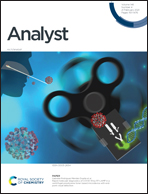A potential-resolved electrochemiluminescence resonance energy transfer strategy for the simultaneous detection of neuron-specific enolase and the cytokeratin 19 fragment†
Abstract
An electrochemiluminescence resonance energy transfer (ECL-RET) immunosensor was developed based on the potential-resolved technology for the simultaneous detection of neuron-specific enolase (NSE) and the cytokeratin 19 fragment (CYFRA21-1). The absorption spectrum of gold nanorods (AuNRs) perfectly overlapped with the ECL spectra of SnS2@Pt and Ru(bpy)32+/Zn-MOF, so they exhibited an excellent ECL-RET effect with high efficiency. Zn-MOF possesses a large surface area, which allows for the loading of Ru(bpy)32+. This results in a signal probe of Ru(bpy)32+/Zn-MOF/Ab1 showing a strong ECL emission. Simultaneously, owing to the excellent electronic conductivity of PtNPs, they can increase the electron transfer rate between S2O82− and tin disulfide nanoflowers (SnS2NFs). Hence, the ECL signal of SnS2NFs can be enhanced. Under the optimal conditions, the linear range for NSE is 0.2 pg mL−1–20 ng mL−1 with a detection limit of 79 fg mL−1. The linear range for CYFRA21-1 is 1.25 pg mL−1–12.5 ng mL−1 with a detection limit of 0.43 pg mL−1. The proposed immunosensor can be used for the sensitive simultaneous detection of NSE and CYFRA21-1 in human serum and has promise for clinical diagnostics.



 Please wait while we load your content...
Please wait while we load your content...